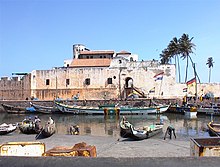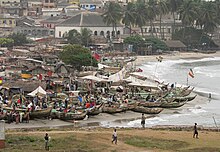Elmina
Elmina ( Portuguese São Jorge da Mina ) is a city in Ghana ( Central Region ) with 25,560 inhabitants (as of January 1, 2005), around ten kilometers west of the city of Cape Coast . The city is the capital of the Komenda / Edina / Eguafo / Abirem district . Like many places on the coast of Ghana, Elmina also has an acan name : Edina .
The place was created as a Portuguese fort and the first European military and trade base south of the Sahara . The Elmina Castle (or St. George's Castle or Elmina Castle ) was built right on the beach. The fort had changing European owners and played an important role both in internal African conflicts (between the Fanti Confederation and the Ashanti Empire ) and in the conflict between Great Britain, i.e. the later colonial power of today's Ghana and the Ashanti Empire in the 18th and 19th centuries. Century. In 1652 the Dutch built another fort in Elmina, called Fort St. Jago da Mina or Fort Conraadsburg . Both forts are on the list of the 1979 UNESCO - World Heritage Site .
economy
Although tourism - especially for the two forts mentioned above - is of increasing importance, Elmina lives mainly from fishing. However, there has been a steady decline in catches in recent years. The reason for this lies in the overfishing of the waters off Elmina by an increasing number of fishing boats, but above all by illegal fishing practices, such as nets that are too close-knit, in which young fish are also caught.
history
According to tradition, Elmina's founder and first king was a hunter named Kwa Amankwa. He and his family had once emigrated south from Techiman , or a point further north, and lived in Eguafo for a while. It was here that Kwa Amankwa discovered the Benya River one day while hunting and was invited by Benya, the river deity of the same name, to settle on its bank. Benya promised, if he would be honored, to provide the people with fish. Kwa Amankwa accepted the invitation and the later Edina or Odena, called Elmina by the Europeans, grew out of his settlement.
In 1471 the Portuguese under João de Santarém and Pedro or Pêro Escobar first sailed the local coast. In 1482 the Portuguese asked a local ruler, whom the Portuguese sources referred to as "Caramansa", for permission to build a fortification as a trading post. In January 1482 the foundation stone for the construction of the fort was laid by Diogo de Azambuja and the place quickly developed into the headquarters of the Portuguese on the West African gold coast. Elmina was on the border of the two kingdoms of Fetu and Kommenda , with the Benya River flowing through Elmina forming the border. The fort built on the western bank of the river mouth was therefore in the area of Kommenda (Eguafo). The Portuguese paid regular donations / gifts to both kingdoms for the right of use in Elmina.
Already in 1486 the place received city rights. It became the main Portuguese trading center for spices , gold , ivory , peanuts and slaves in exchange for fabrics, glass beads and brass. From here the Portuguese also organized their trade with a number of African empires of the Akan , Wassaw and others. Although the settlement has a rather unhealthy climate despite the good drinking water , the post of governor or capitão-mór of Elmina was considered one of the most honorable in Portugal in the 16th century. From 1500 the Christian proselytizing of the African inhabitants of the region began. The first chapel was built in 1503.
In the 16th century, the Portuguese part of the place was inhabited by a governor and the corresponding administrative officials, by traders and craftsmen, by day laborers and seamen, two to four clergy, 20 to 60 soldiers and their respective families.
In 1603, 1606 and 1607 the Dutch tried in vain to conquer Elmina.
In 1615 an earthquake damaged the fort and caused the fortress walls and one of the bastions to collapse. The fort got a completely new look during the reconstruction.
In 1625 the Dutch tried again to take Elmina with a fleet of 15 ships under Jan Dirickszon. This attack, led with great superiority (around 1,200 Dutch), failed with great losses due to the counterattack organized by the Portuguese governor Francisco de Sotomaior by his African allies.
In August 1637 the Dutch reappeared with nine ships and around 800 soldiers in front of Elmina. After only three days, the fort fell on August 29 with the support of locals from Elmina and Kommenda. The Dutch built a garrison of about 150 soldiers and strengthened the fortifications by building a second fort. By 1700 Elmina had 12,000 inhabitants.
During this time, the area around Elmina had changed its affiliation to African rulers several times. In 1701, a few hundred kilometers north of Elmina, the army of the Ashanti Empire defeated the army of the Denkyra . The Ashanti also captured a piece of paper with the lease agreement for the Elmina fortress, originally concluded between the Dutch and the local chiefs of the Kommenda. After the conquest of the Kommenda area by the Denkyra, the contract passed into their possession. The Ashanti entered this contract as a legal successor as a partner of the Dutch. For the first time they had direct access to trade with European merchants via Elmina. Through Elmina they could export gold and slaves without intermediate trade and Elmina became their main source of supplies of rifles and ammunition.
For the Dutch, Elmina was also a recruiting center for colonial soldiers in the 19th century . Between 1831 and 1872 about 3,000 Africans from the interior of the country or from the city itself were brought via Elmina to Batavia (today's Jakarta ), the capital of the Dutch East Indies , to fight for the Dutch colonial rulers. After their contracts expired, some of these soldiers called Belanda Hitam (Javanese for "Black Dutch") returned to Elmina. There they were assigned parcels behind the Dutch fort (today's Fort Sao Jago da Mina ) on a hill that is still called " Java Hill " today. At St. George's Castle, the veterans also received their pensions. But today there is no longer any group that can be identified as descendants of the Dutch colonial soldiers. The memory of this shared Ghanaian-Indonesian history has been kept alive in Elmina for some time by its own Java museum.
In 1872 the Dutch sold Elmina to Great Britain , triggering a war between the powerful Ashanti, who insisted on their suzerainty over Elmina, and the British. In the Treaty of Fomena in 1874, however, the defeated Ashanti had to give up their claim to Elmina.
Elmina was added to the newly established British Gold Coast Colony that same year, as did other parts of southern Ghana . The European trading base Elmina, which was based on various leases with local rulers, had become part of a British colony and remained so until Ghana's independence in 1957.
Later, the German director Werner Herzog shot the film Cobra Verde with Klaus Kinski in the leading role at the fort .
Cultural highlights
Elmina is familiar with two main celebrations that take place every year: the Bakatue and Bronya festivals. The Bakatue is held annually at the end of June / beginning of July and serves to commemorate the founding of the city and the veneration of both the city founder Kwa Amankwa and Benya, the river deity, in order to invoke a new rich fishing season. The festival is framed by ceremonies, which symbolically close and reopen the Benya for fishing. The second main annual celebration is the Bronya festival, which in Elmina is always celebrated on the first Thursday of the new year. It is above all a festival that is celebrated in families and has ancestor veneration as its object.
Twin cities
-
 Macon (Georgia) , USA
Macon (Georgia) , USA
-
 Gouda , Netherlands
Gouda , Netherlands
See also
literature
- Kwame Yeboah Daaku: Trade and Politics on the Gold Coast, 1600-1720. A study of the African reaction to European trade . Clarendon Press, Oxford 1970, ISBN 0-19-821653-X ( Oxford studies in African affairs ), (Also: Dissertation, University of London 1964).
- Albert van Dantzig: Forts and Castles of Ghana . Sedco Pub Ltd, Accra 1980, ISBN 9964-720-10-6 (reprint: 1999 ibid).
Remarks
- ↑ the Kingdom of Kommenda, also: Commany, Groß-Kommenda, Commende or similar.
- ↑ http://elwininternational.com/elmina_java.html
Web links
Coordinates: 5 ° 5 ′ N , 1 ° 21 ′ W



